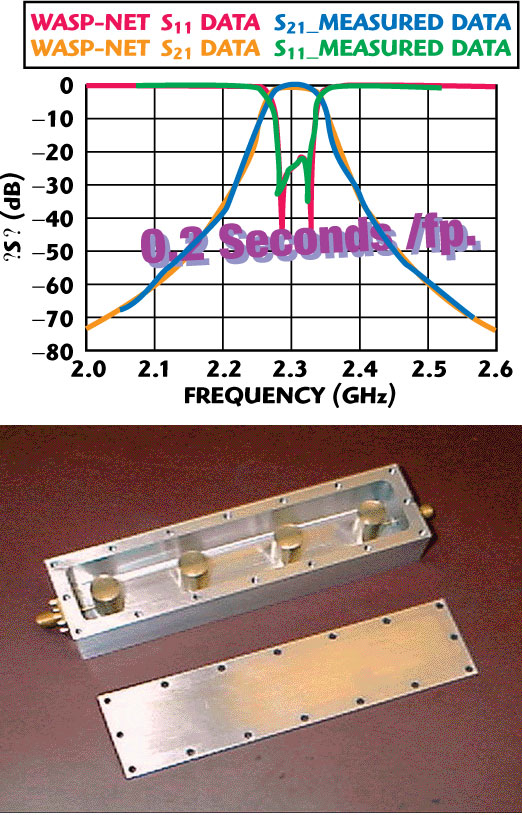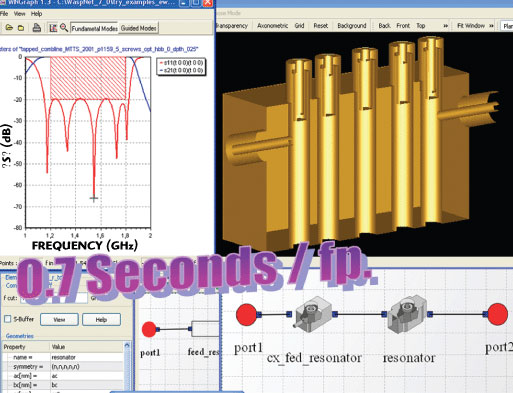
The demand from the microwave and space industry for a drastic reduction in the time-to-market for new components and systems requires fast CAD tools, yielding reliably accurate, optimized designs within extremely short response cycles. Common electromagnetic (EM) simulation using single global three-dimensional (3D) solvers—mostly based on finite element (FE) or finite difference (FD) techniques—yields the desired flexibility, but can require long design and optimization times. On the other hand, mode-matching (MM) solvers and their extensions can provide efficiency, but may not be so flexible. For radiating structures, method-of-moment (MoM) solutions can be advantageous, but simulation times can also be comparatively long.
MIG’s well established WASP-NET® EM CAD and optimization tool uses fast hybrid MM/FE/MoM/FE techniques, which typically go beyond the capabilities of single/dual methods. The latest version, version 7.0, expands the tool’s capability and functions even further. Particular advances include a significant breakthrough in EM design and optimization speed, extended synthesis wizards and a new user-friendly graphical user interface (GUI).
The fact that when using version 7.0, EM simulation times can typically be reduced on standard low-cost dual core PCs (without additional hardware acceleration tools) to only a few seconds for the likes of common coaxial microwave components, dielectric loaded horns and large antennas will be of great interest to design engineers as will be illustrated here. Furthermore, for filters and arrays, appropriate synthesis wizards provide good starting values for subsequent EM optimizations. To illustrate these features graphically, consider the following design examples.
Combline Filters
Due to their compactness and suitability for low-cost mass-production, combline filters have found widespread applications. It is widely recognized that such filters pose a challenge to CAD packages in terms of efficiency due to their complex structure. To address this issue, version 7.0 of WASP-NET incorporates new basis functions that provide high accuracy and flexibility in combination with extremely high efficiency.

Fig. 1 A tapped resonator combline filter with circular posts without tuning screws, and theory/measurement results (picture and measurements courtesy of University of Bremen, Germany).
Figure 1 shows a tapped resonator combline filter with circular posts without tuning screws with the measurement results using version 7.0. This analysis has a calculation speed of about 0.2 seconds per frequency point on a normal 2.3 GHz Core2Duo PC.

Fig. 2 Combline filter synthesis wizard and GUI for the filter shown in Figure 1.
Providing the initial design values for combline filters, Figure 2 shows WASP-NET version 7.0’s user-friendly filter synthesis wizard with the new GUI that incorporates all features expected of a modern CAD interface. Simply starting from desired specifications, after typically about 15 to 30 minutes, the synthesis tool yields the complete full-wave design to be immediately visualized by WASP-NET’s graphics output tool and to be optimized further, if necessary.

Fig. 3 Simulation results for a top capacitance loaded combline filter with tuner-down resonators.
Figure 3 demonstrates the high flexibility combined with the high efficiency of the new approach through the example of a more complicated combline filter with top capacitance loaded tuner-down resonators. The calculation speed of only about 0.7 seconds per frequency point (2.3 GHz Core2Duo PC) demonstrates that direct EM design and optimization of such filters using WASP-NET version 7.0 can result in extremely short design-cycles.

Fig. 4 Optimization results for a coaxial stub loaded filter.
Coaxial Stub Loaded Filter
The next example of a coaxial stub loaded filter (see Figure 4) giving a simulation speed of 0.5 seconds per frequency point (2.3 GHz Core2Duo PC) illustrates that the utilization of the interactive design from scratch, by conveniently using building-blocks such as the coaxial T-junction, and subsequent optimization yields the desired specifications. Figure 4 also demonstrates the extremely high dynamic range (> 300 dB) of the new CAD approach that facilitates the clear identification of possible spikes and their elimination during optimization.

Fig. 5 Theory/measurement results for a horn loaded with dielectric slabs (horn dimensions and measured results courtesy of Dr. Ratajczak, France Telecom R&D).
Dielectric Loaded Horn
The first antenna example for which measurements are available is a dielectric loaded horn that the European Space Agency (ESA) also uses for benchmarking purposes. Figure 5 demonstrates that even with dielectric material to consider, the calculation time using WASP-NET version 7.0 is still 14 seconds per frequency point (2.3 GHz Core2Duo PC).

Fig. 6 A 1,200 slot array showing the synthesis wizard, synthesis result, feed optimization and overcall simulation results.
Slot Arrays and Feeds
In order to demonstrate the tool’s performance when used for large arrays, a 1,200 slot array example is shown in Figure 6 A convenient slot array synthesis wizard provides initial design values within about 60 seconds (first pattern). The second pattern is the result of the rigorous overall simulation in WASP-NET that takes about 250 seconds (on a 2.3 GHz Core2Duo laptop, 2 GB RAM).
Waveguide feeds, e.g. with inclined slots, can, because of the high calculation speed, be conveniently optimized towards the desired specifications. First optimized as an individual sub-circuit (taking 0.8 seconds per frequency point), and then within the overall structure.
Versatility
The versatility of the new CAD tool can drastically reduce design cycles for a large range of industrial design projects involving structures such as waveguide filters, couplers, transformers, transitions, hybrids, diplexers and multiplexers; coaxial components, combline/interdigital filters and diplexers; polarizers, ortho-mode transducers (OMT) and phase shifters; dielectric resonator filters and dielectric loaded waveguides; waveguide and coaxial dissipative filters; corrugated horns, choked horns, horn clusters, reflectors, sub-reflectors, lenses and radomes; and slot arrays, side-slots with shield, etc.
Advanced Features
As well as those already outlined, WASP-NET version 7.0 includes all of the features that would be expected of the latest CAD tool. These include full 64-bit capability, a parallelized code for multiprocessors, adaptive sweep and a direct antenna pattern optimization capability.
Conclusion
The demands on modern EM-based CAD software used for designing microwave components and antennas require a new dimension of efficiency and simulation speed. Version 7.0 of MIG’s comprehensive hybrid EM CAD tool WASP-NET meets this speed challenge, together with flexibility and accuracy, by evoking fast hybrid MM/FE/MoM/FD techniques and hence utilizing the advantages of all solvers while largely avoiding their disadvantages. The breakthrough in speed improvement, the new GUI and extended synthesis wizards provide the microwave engineer with advanced EM design efficiency standards. Based on industrial customers’ specifications, immediate, direct, accurate, EM interactive design and optimization performance for microwave components and antennas can be achieved by combining EM accuracy with extremely short design and optimization cycles.
Microwave Innovation Group GmbH & Co. KG,
Bremen, Germany, + 49 (421) 223 79660,
mig@mig-germany.com,
www.mig-germany.com.
RS No. 300
